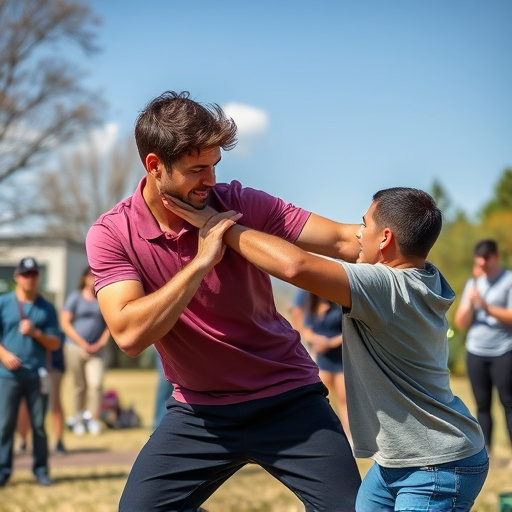College students face unique personal safety challenges, including late-night walks, alcohol-fueled risks, and location sharing on social media. Self-defense classes tailored for them offer vital skills like awareness, assertive body language, verbal de-escalation, and basic strikes to deter attackers and escape dangerous situations. Creating a Personal Safety Plan, using reliable communication devices, emergency apps, and trusted contacts, along with regular safety workshop attendance, enhances preparedness. Technology, such as personal safety apps and campus access control systems, plays a crucial role in enhancing self-defense. Mental preparation techniques like mindfulness and assertive behavior further boost confidence and situational awareness, enabling students to stay calm under pressure.
Navigating college life presents unique challenges, from academic pressures to unfamiliar environments. For students, ensuring personal safety is paramount. This article equips you with essential tools for self-defense, offering a comprehensive guide tailored to college students. We explore fundamental skills, from basic martial arts moves to creating effective safety plans. Learn how technology can boost security and discover mental techniques to build confidence and awareness. By implementing these strategies, you’ll gain the knowledge and peace of mind needed to thrive in your academic journey.
Understanding the Unique Challenges of College Life
College life presents unique challenges that can make students vulnerable, especially when it comes to personal safety. With many young adults living independently for the first time, they may lack experience in navigating potentially dangerous situations. Late-night walks home from the library or returning to dormitories after dark can be risky, and with alcohol involved, these risks increase. Social media also plays a role, as students might share their locations or plans, unintentionally inviting trouble.
Self-defense classes specifically tailored for college students are an excellent way to empower them to face these challenges. These courses teach practical skills to protect against common threats, such as assault and robbery. They promote awareness, enabling students to identify potential dangers and avoid hazardous situations. Moreover, self-defense training boosts confidence and encourages a sense of agency, crucial elements in ensuring the safety and well-being of college students.
Essential Self-Defense Skills for Beginners
For college students new to self-defense, learning a few essential skills can be incredibly empowering and beneficial in navigating unfamiliar environments. Basic self-defense begins with awareness—being alert and observant of your surroundings at all times. This includes recognizing potential threats early on and understanding when to retreat or de-escalate a situation. Simple yet effective techniques like assertive body language, verbal de-escalation strategies, and basic strikes can deter attackers and buy valuable time for escape.
One fundamental skill is the ability to deliver powerful kicks and punches accurately. Learning proper form ensures maximum impact and minimizes injury risk. Students should practice striking targets that mimic common attack points on an attacker’s body. Additionally, understanding how to fall safely and break a fall can prevent serious injuries during a struggle. These foundational skills provide college students with practical tools for self-defense, boosting their confidence and preparedness in potentially dangerous situations.
Creating a Personal Safety Plan: A Step-by-Step Guide
Creating a Personal Safety Plan is an essential step for college students looking to enhance their safety and well-being. Start by familiarizing yourself with your campus layout, identifying safe routes between classes or dormitories, and noting visible security features like cameras or guards. Next, invest in reliable communication tools; ensure your phone is fully charged at all times and consider downloading emergency apps tailored for campuses.
Create a network of trusted contacts who can be reached 24/7. Include local law enforcement, campus security, and personal friends or family members. Regularly review and update this plan as you become more familiar with your surroundings. Additionally, attend any safety workshops or seminars offered by your college to gain practical tips and strategies for self-defense in various scenarios, reinforcing your ability to stay safe while embracing the independence of college life.
Utilizing Technology for Enhanced Security
In today’s digital era, technology offers powerful tools for enhancing security measures, especially for self defense for college students. Apps designed for personal safety allow users to quickly alert authorities or trusted contacts in case of emergencies, often with GPS tracking for precise location sharing. Additionally, many colleges are implementing access control systems and surveillance technologies to deter threats and facilitate faster response times during incidents.
These technological advancements complement traditional self-defense strategies. Students should still be educated on basic safety protocols like recognizing high-risk situations, trusting their instincts, and knowing emergency procedures. By combining these approaches, self defense for college students can create a multi-layered framework that promotes security and peace of mind in an increasingly connected environment.
Building Confidence and Awareness: Mental Preparedness Techniques
Building confidence and awareness is a crucial aspect of self-defense for college students. It starts with mental preparation techniques that empower individuals to stay calm under pressure. Students can enhance their situational awareness by practicing mindfulness, always being aware of their surroundings, and trusting their instincts. Regular meditation or deep breathing exercises can help reduce stress and anxiety, allowing for quicker decision-making during potentially dangerous situations.
Confident behavior also plays a significant role. Students should project an air of assertiveness without aggressiveness. This includes maintaining good posture, making eye contact, and using firm but calm language to communicate their boundaries. Such mental fortitude can deter potential attackers and give students the mental edge needed for effective self-defense strategies.
